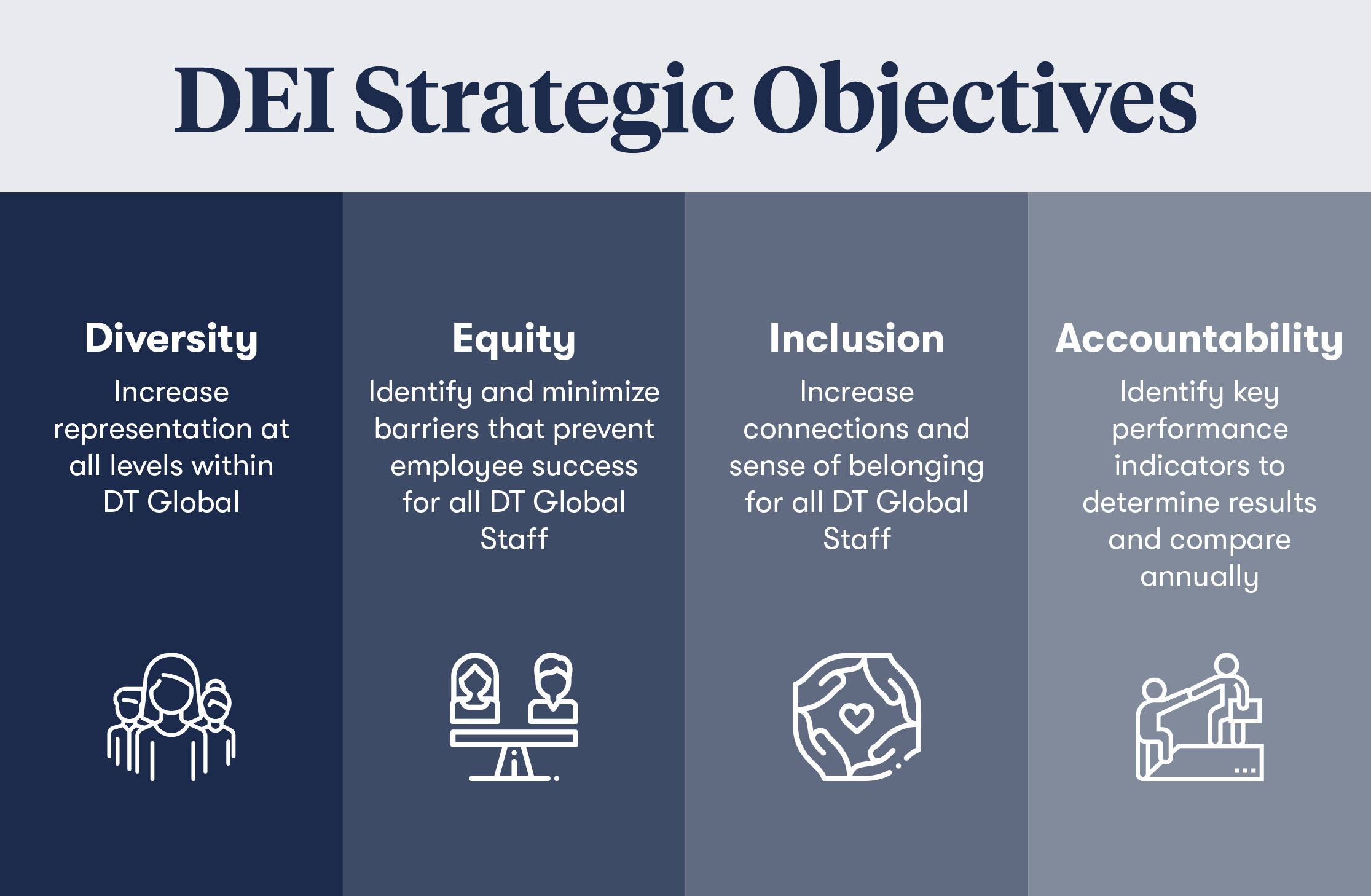
DT Global US’s Senior Human Resources Director, Cara Gettridge, knew from the start of her tenure at the company that diversity, equity, and inclusion (DEI) was a core area she wanted to work on. Not only is effective DEI policy necessary to build a successful company, but it is also a passion of hers. But as the architect of DT Global US’s DEI initiative, she knew she needed staff to get involved.
“Diversity, equity, and inclusion is everyone’s responsibility,” says Mrs. Gettridge. “All people want to be treated fairly and feel a part of an organization. A staff-led DEI working group creates an opportunity for diverse thought and perspective, intentionally focused on impactful change and built on respect and inclusion. Together we can foster the change we want to see within our organization.”
Today, DT Global US has a DEI working group that prioritizes long-term goals identified by staff through surveys and other feedback, creates key performance indicators and action plans based on these goals, and then implements activities to meet these goals.
While the work this group does is based on staff needs and staff feedback, it also looks outside of DT Global. Grounded in external research and ideas from colleagues in other organizations, the structure and initiatives of this group draw on learning from the wider DEI space. To give some of this learning back, here’s an overview of how we started, how we’re organized, how it’s going, and what’s next.
Mrs. Gettridge understood that to create a truly equitable and inclusive environment at DT Global, it was important to begin from a place of honesty—and having difficult but necessary conversations with staff was the starting point. She initiated a series of all-staff consultations in early 2020 around DEI, led by an outside facilitator, Audrey Roofeh of Mariana Strategies. Mariana Strategies also created a survey about DEI to bolster understanding of what was working, what wasn’t, and steps forward.
Mrs. Gettridge was careful to ensure that staff discussion groups were organized thoughtfully—for instance, giving safe space to staff of color, or separate space for employees and managers—so that individuals could feel freer to have forthright conversations. This includes having honest conversations with staff who were downright exhausted by the check-the-box DEI conversations that yielded no real change. She also maintains an anonymous comment box and open-door policy so that staff know they can come to her privately at any time.
The group is comprised of six staff and one Senior Management Team member who volunteer for a 6-to-12-month basis. The group meets monthly with each other, and quarterly with DT Global US’s senior leadership team to brief them on the work and get feedback. The DEI working group developed a DEI change model to identify major areas that needed work and chart a path for what change would look like in each of these areas.
In the second half of 2020, after conducting the staff consultations, Mrs. Gettridge put out a call for volunteers to form a DEI working group. The group began with creating an organizational structure and operational guidelines for itself. To start, members created an organizational vision for how DT Global US is committed to DEI and the objectives of the working group. The group also decided on working guidelines, such as when to meet (biweekly at first, now monthly to allow for more time for staff to work on initiatives) and how members work with the Senior Management Team (once quarterly meeting for feedback).
In 2021, the group began working on creating information and resources for the wider DT Global US. This included creating a Diversity, Equity, and Inclusion Overview course which is now required for all staff; a DEI one-pager for staff; a Diversity, Equity, and Inclusion Policy to inform DEI decisions for the company; and a DEI folder with guidance, tools, and resources located on the company’s file-sharing system.
After creating resources, the group turned to proactive initiatives for staff. Based on the organizational change model initially developed, our DEI working group identified three main areas to work on: recruitment, growth, and retention (integrating DEI concepts into how we recruit and retain staff); inclusive culture (creating inclusive space so all staff feel they belong); and accountability (measuring our progress in the DEI space and communicating it effectively to staff). In addition to the DEI Overview course, which supports retention, the group developed new recruitment practices, a more inclusive holiday leave policy, and feedback loops for communication and accountability.
Our new recruitment practices include DEI-related questions in interview questions, DEI questions in candidate reference checks, and a modified Rooney Rule (meaning that at least one person from an underrepresented group will be considered for any open position, including senior positions). Our inclusive Floating Holiday Policy allows staff the opportunity to celebrate their chosen religious and cultural holidays with time off, rather than mandated time off for Christian or Federal holidays. We also did an audit of the accessibility of our social media and website and made upgrades to improve both. The group has instituted regular email communication and a staff Lunch and Learn discussion to keep the wider DT Global informed of DEI initiatives and offer opportunities for feedback.
Of course, our work is just beginning. In October Mrs. Gettridge got a batch of six new volunteers who will rotate into the group. Two of the prior group members will remain for two months to help with the transition. The working group is exploring a range of new initiatives, including staff mentoring, affinity groups, new ways to measure our work and hold ourselves accountable. DEI is a crucial component of an effective organization, and we’re excited to keep working toward a more inclusive company for all.
What methods have worked for your organization? What do you want to see with DEI?